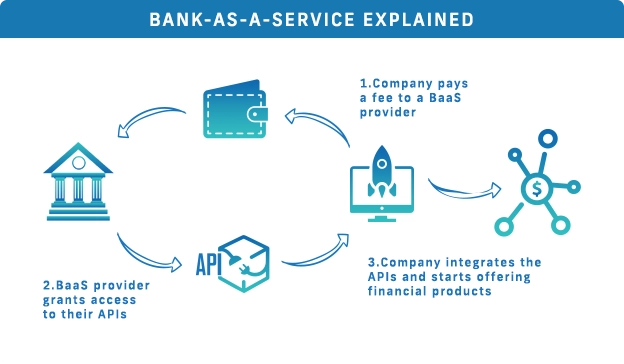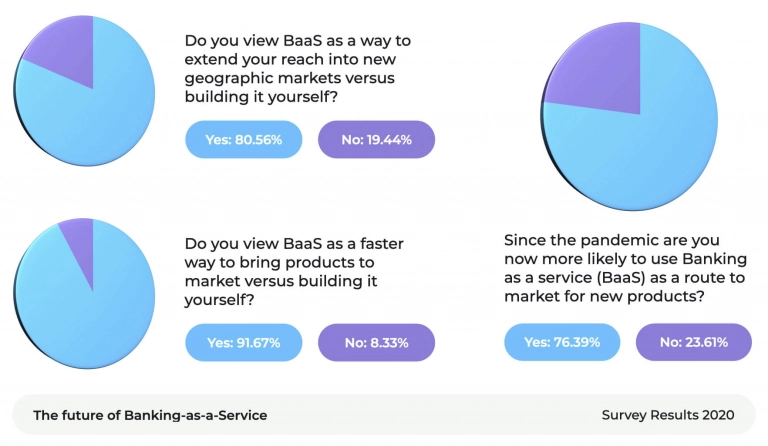A transformative force is quietly revolutionizing the way financial services are delivered. This force is none other than banking as a service in fintech, a concept that empowers non-financial companies to embed financial services directly into their own platforms seamlessly.
BaaS is the brainchild of forward-thinking fintech companies that recognize the immense potential of leveraging their expertise to democratize access to financial solutions. By providing businesses with a robust toolkit of APIs and infrastructure, BaaS eliminates the need to reinvent the wheel, enabling them to focus on their core competencies while gaining access to a wealth of financial capabilities.
The implications of banking as a service for fintech are far-reaching, disrupting the traditional financial ecosystem and paving the way for a more inclusive and accessible financial future. Businesses of all sizes, from e-commerce giants to social media platforms, can now integrate financial services into their offerings, enhancing customer experiences, expanding product portfolios, and optimizing operational efficiency.
In this article, we will talk about:
- What banking as a service technology is, and how it works
- The benefits of BaaS for businesses and consumers
- Examples of how BaaS principles are being used by businesses today
- The potential impact of BaaS on the future of finance
BaaS vs. embedded finance
Amidst this dynamic environment, two distinct approaches have emerged as critical catalysts for change: BaaS and embedded finance . While these concepts share similarities, they exhibit particular features and cater to different business objectives.
| Feature | Banking-as-a-Service (BaaS) | Embedded Finance |
| Definition | BaaS is a cloud-based service that allows non-financial companies to offer financial services through their platforms. | Embedded finance is a broader term that encompasses the integration of financial services into non-financial platforms. |
| Focus | BaaS integration primarily provides access to core banking services, such as account opening, payment processing, and lending . | Embedded finance encompasses various financial services, including payments, lending , investments, and insurance. |
| Target audience | BaaS is primarily targeted at non-financial companies that want to offer limited financial services to their customers. | Embedded finance is targeted at a broader range of businesses, including non-financial companies, fintech companies, and financial institutions. |
| Advantages | Reduced development time and cost: BaaS providers handle the most development and infrastructure work, so businesses can quickly and easily add financial services to their platforms. | Scalability: Embedded finance platforms can be scaled easily to accommodate the growing demand for financial services. |
| Disadvantages | Limited control: Businesses that use BaaS depend on the BaaS provider for the security, compliance , and overall performance of their financial services. | Data privacy concerns: Embedded finance platforms may collect and store sensitive financial data, raising data privacy concerns. |
BaaS provides a robust toolkit for the seamless integration of core financial services. The ongoing "BaaS vs. embedded finance" discourse isn't a binary decision but hinges on understanding specific needs and goals. It involves selecting an approach that empowers businesses to construct a genuinely integrated and transformative financial ecosystem tailored to their customers.
Both BaaS and embedded finance are potent tools for non-financial companies aiming to enhance their offerings with financial capabilities. The decision between the two depends on specific business objectives and the desired level of customization. BaaS platform providers can offer advantages to businesses prioritizing speed and cost efficiency by ensuring a standardized place to integrate core financial services.
Applications and strategic value of BaaS

BaaS platforms provide businesses with access to a wide range of financial capabilities, allowing them to expand their product offerings beyond their core competencies. This can be achieved by integrating features such as:
- Payment processing: Businesses can offer their customers secure and convenient ways to pay for online and offline goods and services.
- Loans and financing: Businesses can provide their customers with access to credit and financing options, which can drive sales and loyalty.
- Investments and wealth management: Businesses can offer their customers tools for managing their investments and finances, enhancing customer satisfaction and loyalty.
- Insurance: Businesses can embed insurance products into their offerings, providing customers additional protection and peace of mind.
Improving the customer experience
BaaS platforms can be used to enhance the customer experience by providing seamless integration of financial services into existing platforms. This can be achieved by:
- Streamlining payment processes: Using banking as a service platform, customers can make payments quickly and easily without switching between different platforms.
- Personalizing financial experiences: Businesses can provide tailored financial recommendations and services based on customer data and preferences.
- Creating a frictionless user experience: Customers can access a wide range of financial services without having to create multiple accounts or provide redundant information.
Increasing efficiency
BaaS platforms can help businesses to improve operational efficiency by automating and streamlining financial processes. This can be achieved by:
- Managing customer data: Businesses can centralize and manage customer financial data securely and effectively.
- Processing payments: Businesses can automate payment processing, reducing the risk of errors and improving transaction speeds.
- Tracking financial performance: Using BaaS platforms, businesses can gain insights into their financial performance and identify areas for improvement.
Cost reduction
BaaS platforms can help businesses reduce costs by eliminating the need to invest in and maintain their financial infrastructure. This can be achieved by:
- Outsourcing financial services: Businesses can offload the risk and complexity of managing financial services to BaaS providers.
- Sharing costs with other businesses: Businesses can share the cost of infrastructure and expertise with other BaaS users.
- Real-time access to financial data: Businesses can access real-time financial data, which can help them make more informed decisions.
Strategic value of BaaS

- Improving competitiveness: Businesses can differentiate themselves from competitors by offering innovative and personalized financial services.
- Implementing innovations faster: Businesses can access new financial technologies and solutions more quickly, enabling them to respond to market trends and customer needs.
- Expanding to new markets: Businesses can reach new customers and expand their market reach by offering financial services to customers in other geographies.
- Accessing new revenue streams: Businesses can generate new revenue streams by offering financial services to their existing customer base.
- Strengthening customer relationships: Businesses can enhance customer relationships and loyalty by providing a comprehensive suite of financial services.
The BaaS model can help businesses achieve their strategic goals and thrive in the competitive fintech landscape.
Build cutting-edge, compliant fintech solutions with Binariks
Banking services accessible through BaaS
In addition to the points we mentioned in the previous section, several other banking services can be accessed through BaaS.
Payments
BaaS providers offer payment solutions, including payment processing, secure transactions, and alternative payment methods like mobile wallets and QR codes. Businesses can integrate these payment options into their platforms, enabling customers to make payments directly within their existing ecosystem.
Account opening and management
BaaS enables businesses to provide their customers with integrated account opening and management services. This includes capabilities such as account creation, verification, and account maintenance, allowing companies to offer their customers a more streamlined financial experience.
Lending and financing
BaaS providers help businesses with access to lending and financing solutions , enabling them to offer their customers credit options, loans, and other financial products. This can help businesses expand their customer base and generate additional revenue streams.
Wealth management
BaaS can be used to integrate wealth management tools and services into non-financial platforms. This enables businesses to offer their customers investment management, portfolio tracking, and financial planning advice, catering to their growing financial needs.
Insurance
BaaS facilitates the integration of insurance products and services into non-financial platforms. This empowers businesses to offer their customers protection against various risks, such as health, property, and life insurance, enhancing their overall financial well-being.
Cross-border transactions
BaaS services offer solutions for cross-border payments and transactions, enabling businesses to facilitate international money transfers and payments. This can expand the reach of companies and cater to customers with global financial needs.
Fraud prevention and risk management
BaaS providers typically incorporate advanced fraud prevention and risk management tools, ensuring the security and protection of customer financial data. This helps businesses maintain compliance with regulatory standards and safeguard customer funds.
Data analytics and insights
BaaS platforms often provide access to data analytics and insights tools, allowing businesses to gain valuable insights into customer behavior, transaction patterns, and financial trends. This can inform data-driven decision-making and improve customer service.
By using these diverse banking services and transactions through BaaS, non-financial companies can transform their offerings and get a competitive edge in the evolving fintech landscape.
At Binariks, we offer a comprehensive suite of APIs and services tailored to your specific needs. Whether you want to add seamless payments, provide innovative financing options, or integrate secure account management, our team can help you navigate the BaaS landscape and achieve your strategic goals.
Binariks provides both technology and BaaS consulting, guidance, and support, ensuring a smooth and successful BaaS integration for your business. Contact us today, adopt BaaS, and experience the future of financial services.
Cryptocurrency Betting Platform
Binariks team revamped a cryptocurrency betting platform
Success stories: Companies excelling with BaaS platforms
Savings and investment services
Non-banks and fintechs are increasingly embracing the BaaS model to assist customers in saving and investing their assets. This approach enables clients to achieve a balanced, personalized savings and investment portfolio through low-cost index funds.
Take, for example, the collaboration between UK-based Starling Bank and Raisin UK, a UK-based savings platform. Through this partnership, Raisin leverages Starling's APIs to establish Starling accounts for its customers. It efficiently manages the collection of customers' savings deposits and facilitates their transfer to partner banks. This setup empowers customers to select the most suitable savings deals available in the market, tailored to their needs (Source ).
Credit and debit card services
BaaS empowers non-banking enterprises to provide credit and debit cards to their customers. Customers can receive real-time updates on all transactions through a dedicated app, facilitating quicker and more efficient payment processes.
An illustrative case is Stash, a fintech company based in New York, employing the BaaS model in collaboration with Green Dot Bank. Utilizing an API, Green Dot seamlessly integrates a Stash bank account into the Stash app, offering customers debit cards without overdraft fees and access to a network of free ATMs across the United States (Source ).
Digital banking
BaaS for fintech and non-fintech enterprises to offer online banking services to their customers. These sophisticated and user-friendly solutions cater to diverse customer needs, including efficient account management and the flexibility to switch accounts seamlessly.
A good example is the collaboration between Abu Dhabi Islamic Bank (ADIB) and Fidor Bank. Fidor Bank, through APIs, meticulously designed, tested, and transformed a digital banking project into a comprehensive digital banking platform. This initiative aims to deliver a seamless and user-friendly experience specifically tailored for Generation Y users, who constitute ADIB's target customer demographic (Source ).
Final thoughts
BaaS stands at the precipice of a financial revolution, empowering non-financial companies to reshape how we interact with and access banking services . This innovative approach is not just about adding financial features to existing platforms; it's about blurring the lines between industries, creating seamless ecosystems where every interaction can be infused with financial potential.
While the possibilities are vast, navigating the intricacies of BaaS can be daunting. Choosing the right provider, ensuring compliance , and integrating services requires expertise and strategic foresight. Yet, the rewards are undeniable: enhanced customer experiences, expanded product offerings, and a competitive edge in a rapidly evolving landscape.
The future belongs to those who embrace innovation and unlock the potential of technology. In the case of BaaS, this means understanding its power to transform interactions , create value, and drive financial inclusion. So, step into the BaaS revolution, partner with the right players, and watch your business flourish in a world where finance is woven into the very fabric of everyday life.
Remember, BaaS is not just a tool; it's a catalyst for change, pushing the boundaries of what's possible and redefining the very concept of financial services. Are you ready to unlock its potential?
Share

